Networks of internationalizing digital platforms in physical place and digital space
Abstract
Research Summary
The existing literature provides contradictory evidence on how digital platform firms establish network relations for internationalization. Some studies argue that they all but obviate the need for traditional relations in physical places. Others argue that these firms can suffer from overreliance on online interactions in digital space. We examine the coexistence of the network relations of international digital platform firms in physical place and digital space. Our multiple-case study identifies three coexistence mechanisms: reinforcement, separation, and simulation. These mechanisms are conditioned by three respective modes of bordering between physical place and digital space: soldering, interosculation, and division. We contribute to the network approach to internationalization and formulate implications for the concepts of location and borders in international business.
Managerial Summary
International digital platform firms establish traditional network relations in physical places and rely heavily on online interactions in digital space. However, how do they combine their networking activities in these two localities? We examine the coexistence of the network relations of international digital platform firms in physical place and digital space and identify three coexistence mechanisms: reinforcement, separation, and simulation. These mechanisms are conditioned by three respective modes of bordering between physical place and digital space: soldering, interosculation, and division. We show that international platform companies, despite being digital in nature, are well advised to pay attention to not only digital but also actual physical networking, and that they come to see these as mutually nurturing.


 求助内容:
求助内容: 应助结果提醒方式:
应助结果提醒方式:


